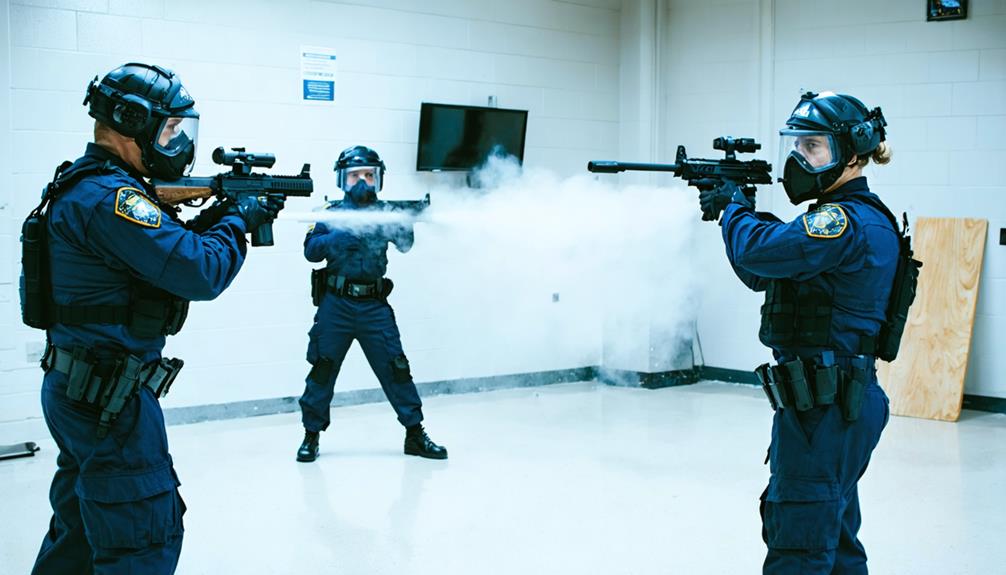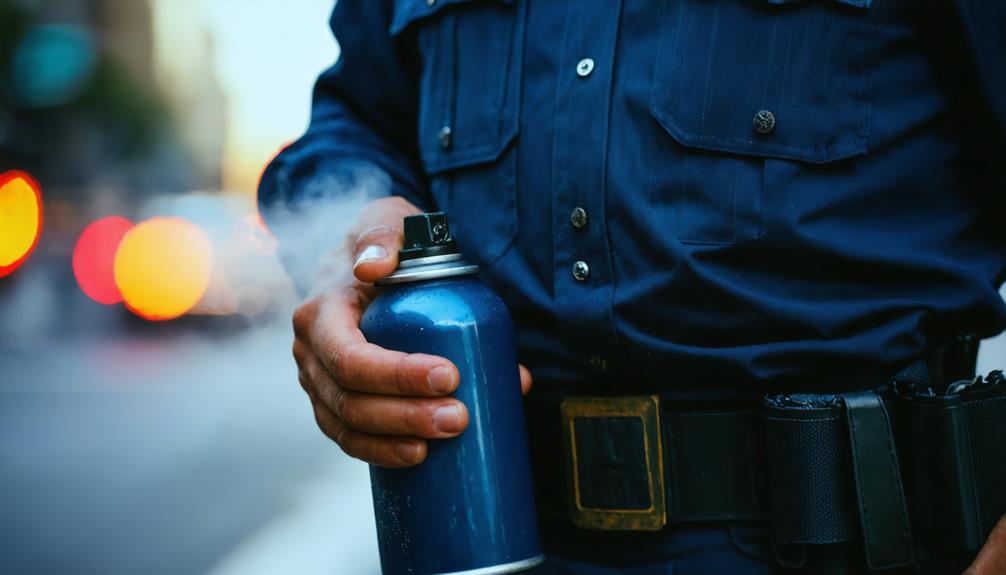
Brainstorm Security Shop

For Orders Over $199

On Any Of Our Products

Details On Refund Page
The deployment of police mace spray has long sparked intense discussions about its role in modern law enforcement. As a non-lethal option, its ability to incapacitate individuals temporarily is both an asset and a subject of scrutiny. While its chemical makeup, primarily Oleoresin Capsicum, is effective in dispersing crowds or subduing suspects, questions arise about the potential health risks and ethical responsibilities tied to its use. As agencies navigate these concerns, the evolving conversation around mace spray’s future in policing poses critical questions that challenge the balance between maintaining order and ensuring public trust. What lies ahead in this ongoing debate?
The development of mace spray as a tool for law enforcement has its roots in the mid-20th century, reflecting the broader evolution of non-lethal weaponry. Initially, the concept emerged as a response to the need for alternatives to traditional firearms, aiming to mitigate potential fatalities during confrontations. The introduction of chemical agents for crowd control and personal defense marked a significant shift in policing techniques, emphasizing incapacitation over lethality.
Mace spray quickly gained traction due to its effectiveness and relatively minimal long-term harm. The historical evolution of mace spray aligns with a period of growing societal concerns over police brutality and the ethical implications of force. As law enforcement agencies worldwide began adopting mace, it became emblematic of a new approach to maintaining order—one that balanced authority with a commitment to reducing harm.
Cultural perceptions of mace spray have been varied, often influenced by its portrayal in media and its use in high-profile incidents. While some view it as a necessary tool for police, others criticize it as a symbol of excessive force. This dichotomy underscores the complex interplay between evolving law enforcement strategies and public sentiment throughout its history.
The chemical composition of police mace spray primarily includes active ingredients such as oleoresin capsicum, which is responsible for its incapacitating effects.
These active compounds are typically dissolved in solvents and carrier agents to facilitate effective dispersal and adherence to surfaces.
Understanding the interaction of these chemicals with human skin is crucial, as it directly influences both the efficacy and safety of the spray in law enforcement applications.
Within the realm of law enforcement tools, understanding the chemical composition of mace spray is essential for evaluating its efficacy and safety. The primary active ingredient in mace spray is Oleoresin Capsicum (OC), a natural compound derived from hot peppers. This compound is responsible for the inflammatory effects that incapacitate individuals by causing temporary blindness, difficulty breathing, and intense burning sensations.
The potency of OC is measured in Scoville Heat Units (SHU), a factor crucial in mace spray regulations to ensure consistent effectiveness and safety. In law enforcement practices, the concentration of OC in mace spray typically ranges from 5% to 10%, although some formulations may vary based on jurisdictional guidelines and intended use.
It is imperative for regulatory bodies to carefully evaluate and standardize these concentrations to maintain a balance between controlling situations effectively and minimizing potential harm. Additionally, the capsaicinoids, the active components within OC, interact with sensory neurons, leading to the incapacitating effects desired for non-lethal compliance.
Beyond the active ingredient Oleoresin Capsicum, the effectiveness of mace spray also depends significantly on its solvent and carrier agents. These components play a crucial role in determining the spray’s dispersion, potency, and stability.
The solvent types used in mace sprays are selected based on their ability to dissolve the active ingredient efficiently. Commonly used solvents include alcohols and glycols, which facilitate the smooth and rapid delivery of the active component.
Selecting the appropriate carrier methods is equally essential as it influences how the spray is dispersed. The carrier agents are responsible for transporting the Oleoresin Capsicum to its target, ensuring it maintains its intended concentration and efficacy.
Different products might opt for varying carrier methods, such as pressurized gas or liquid carriers, depending on the desired spray pattern and reach.
These solvent and carrier choices significantly impact the overall performance of mace sprays.
Exposure to mace spray can result in a range of effects on human skin due to its chemical composition. Mace, primarily composed of oleoresin capsicum (OC), is a potent irritant derived from chili peppers. Upon contact, the active compounds can penetrate the skin’s outer layers, leading to immediate and often severe irritation.
This skin penetration facilitates the onset of an inflammatory response, characterized by redness, swelling, and a burning sensation. The degree of these effects can vary depending on the concentration of the spray and the duration of exposure.
The oleoresin capsicum in mace spray also contains capsaicinoids, which are responsible for its fiery properties. These compounds bind to the TRPV1 receptors found in sensory neurons, triggering pain and inflammation.
This interaction not only leads to acute discomfort but can also exacerbate pre-existing dermatological conditions. Furthermore, the solvents and carrier agents used in the formulation may enhance the skin’s permeability, augmenting the inflammatory response.

The deployment of police mace spray has significant effects on the human body, primarily impacting the respiratory system, skin, and eyes.
Inhalation can cause coughing, difficulty breathing, and a burning sensation in the throat, while direct contact with skin may lead to irritation and redness.
Furthermore, exposure to the eyes often results in severe pain, tearing, and temporary vision impairment.
When individuals are subjected to mace spray, their respiratory system is often significantly affected, leading to acute discomfort and potential health risks. The active ingredients in mace, typically oleoresin capsicum, can provoke a range of respiratory responses that vary in severity depending upon the individual’s sensitivity and exposure duration.
Immediate respiratory distress is a common reaction, characterized by coughing, shortness of breath, and a burning sensation in the throat.
Inhalation risks associated with mace spray are of particular concern, as the fine particles can penetrate the airways, causing inflammation and irritation. This may exacerbate pre-existing conditions such as asthma or other respiratory disorders.
The following are key impacts on the respiratory system when exposed to mace spray:
Understanding these impacts is crucial for mitigating the potential health risks associated with exposure and ensuring appropriate medical intervention when necessary.
Many individuals experience immediate skin irritation upon contact with mace spray, a common incapacitating agent used by law enforcement. The active ingredients in mace spray, primarily oleoresin capsicum, can cause significant discomfort upon dermal exposure. This irritation is particularly pronounced in individuals with heightened skin sensitivity, leading to burning sensations, redness, and swelling. These symptoms can persist for varying durations, depending on the individual’s reaction and the concentration of the spray.
For those with pre-existing dermatological conditions or heightened skin sensitivity, the effects of mace spray can be more severe. In such cases, the skin may exhibit exacerbated reactions, including blistering or a rash, which can complicate treatment and prolong recovery.
Additionally, some individuals may experience allergic reactions to the compounds within the spray, which can manifest as hives or more extensive inflammation.
Appropriate decontamination measures, such as rinsing the affected area with copious amounts of water and avoiding further irritation, are essential in mitigating these reactions. However, in cases of severe skin irritation or suspected allergic reactions, medical intervention may be necessary to prevent further complications and ensure effective management of symptoms.
Understanding these potential effects is crucial for both law enforcement and the general public.
Exposure of the eyes to mace spray can result in significant and immediate consequences, often characterized by intense pain, burning sensations, and involuntary eyelid closure.
These symptoms can lead to temporary blindness, impairing one’s ability to see and respond to their surroundings. The intense discomfort often compels individuals to seek immediate relief, but improper handling can exacerbate the condition.
The potential for eye damage necessitates a swift response. Mace spray can cause damage to the corneal epithelium, posing risks for prolonged visual disturbances if not addressed promptly.
Emergency treatment should be administered quickly to mitigate these effects. Here are key measures to consider:
Understanding these consequences emphasizes the importance of proper emergency treatment to protect ocular health following mace exposure.
The deployment of mace spray by police forces raises significant legal and ethical considerations that must be carefully examined. Legally, the use of mace spray is governed by a framework of regulations that dictate when and how it should be employed. The legal implications of improper use can lead to serious consequences, including civil liability for law enforcement agencies and officers involved.
Misuse or excessive use of such force could infringe upon individuals’ constitutional rights, leading to potential litigation and loss of public trust. Ensuring adherence to legal standards is paramount to maintaining the delicate balance between enforcing the law and upholding civil liberties.
Ethically, the use of mace spray presents dilemmas that challenge the moral responsibilities of law enforcement. Officers must weigh the necessity of force against potential harm to individuals, particularly in situations involving vulnerable populations.
Ethical dilemmas arise when determining whether the use of mace spray is a proportionate response to the threat faced. Moreover, transparency and accountability in reporting and reviewing such incidents are crucial to uphold public confidence.
A robust ethical framework demands that police forces not only adhere to legal standards but also consider the broader impact of their actions on community relations and human rights.

Effective training and comprehensive guidelines are critical components in the responsible use of mace spray by law enforcement officers. Properly prepared officers are more equipped to make informed decisions regarding the use of mace spray, ensuring both officer and public safety.
Training in mace spray effectiveness and self-defense training are integral, as they provide officers with the skills necessary to assess situations accurately and apply force judiciously. The goal is to enhance officers’ ability to de-escalate potentially dangerous encounters while maintaining control over volatile situations.
To achieve this, training programs often include:
These components are designed to ensure that officers not only comprehend the mechanics of mace spray but also appreciate the implications of its use.
Debating the use of mace spray by law enforcement has sparked significant controversies and criticisms, particularly concerning its potential for misuse and excessive force.
Public perception of law enforcement’s authority to use mace spray often hinges on the balance between maintaining order and infringing on individual rights. Instances where mace spray has been employed in situations perceived as non-threatening have fueled public outcry and skepticism, leading to questions about accountability and oversight.
Misuse incidents have been a focal point in the debate, with numerous reports of mace being deployed inappropriately during peaceful protests or against vulnerable individuals, such as minors or the elderly.
Such cases amplify concerns about training and decision-making processes within police forces, potentially eroding public trust. Critics argue that the lack of clear, enforceable guidelines contributes to inconsistent applications of force, thus exacerbating tensions between the police and the communities they serve.
Furthermore, the visual and physical impact of mace spray incidents, often captured and shared widely on social media, has intensified scrutiny and criticism.
These images can shape and sometimes skew public perception, highlighting the need for transparency and robust policies to govern the use of force, including mace spray, within law enforcement agencies.

Amid the ongoing debates and controversies surrounding its use, the future of mace spray in law enforcement is poised for reevaluation and potential reform.
As communities demand greater accountability and transparency, the landscape of non-lethal force is expected to undergo significant changes. Technological advancements are likely to play a crucial role in shaping the next generation of mace spray, focusing on increased safety and effectiveness. Innovations may include formulations that minimize unintended harm while maximizing deterrent capabilities.
Future regulations will likely align with evolving public sentiments and technological improvements, ensuring that mace spray use is both ethical and judicious. Law enforcement agencies might adopt stringent guidelines and training programs to enhance officers’ understanding and application of these tools.
The integration of data analytics could further refine deployment strategies, ensuring mace spray is used proportionately and appropriately.
In embracing these advancements, law enforcement can enhance public trust and operational effectiveness.
Civilians may use mace spray for self-defense, subject to legal considerations varying by jurisdiction. Prospective users should thoroughly understand local laws and adhere to safety precautions to ensure responsible and effective use of this self-defense tool.
To decontaminate after exposure, flush affected areas with cold water, avoiding hot water to prevent further skin irritation. Remove contaminated clothing and wash skin with mild soap. Avoid rubbing the area to minimize irritation and discomfort.
Common scenarios for deploying chemical deterrents include crowd control, self-defense, and subduing non-compliant individuals. Deployment techniques vary, adhering to legal regulations to ensure minimal harm while maintaining public safety and order during potentially volatile situations.
Mace spray can be effective against animals, altering animal behavior temporarily. The spray ingredients, such as Oleoresin Capsicum, cause irritation and discomfort, deterring aggressive actions. However, effectiveness varies with animal species and specific situational factors.
In the realm of crowd management, several non-lethal options are available. These include rubber bullets, tear gas, water cannons, and acoustic devices. Each method varies in application and effectiveness, requiring careful consideration for safety and ethical use.
The deployment of police mace spray, composed primarily of Oleoresin Capsicum, remains a pivotal yet contentious element of law enforcement operations. Its development and use are continually scrutinized for health impacts and ethical ramifications. Rigorous training and adherence to guidelines are essential to mitigate potential risks and uphold public trust. Ongoing evaluation and discourse are crucial in navigating the controversies surrounding mace spray, ensuring its application aligns with evolving societal standards and the future needs of policing.
